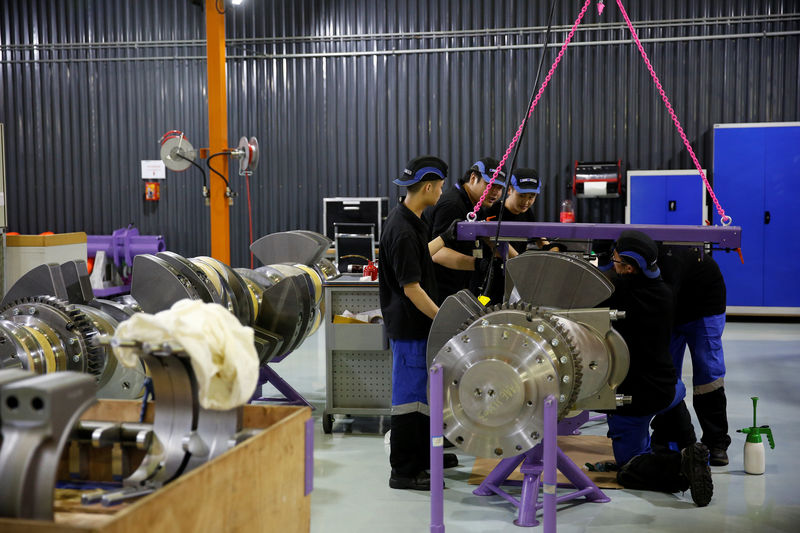By Elias Glenn and Ryan Woo
BEIJING (Reuters) - China's strong economic growth showed visible signs of fading in July as lending costs rose and the gravity-defying property market cooled, though activity levels generally remained solid, propped up by a year-long construction spree.
Industrial output, investment, retail sales and trade all grew less than expected last month, after the world's second-largest economy put in a surprisingly strong showing in the first half, adding fuel to a global recovery.
But economists do not expect any hard landing, with the government keen to ensure stability ahead of a once-in-five-years Communist Party leadership reshuffle in the autumn.
"The upshot is that both foreign and domestic demand appear to have softened at the start of the third quarter," said Julian Evans-Pritchard, China economist at Capital Economics.
"A few sectors, such as steel, seem to have defied this slowdown in economic activity. But the strength in these areas likely won't last given that policy tightening is set to further weigh on infrastructure and property investment in coming months."
Factory output rose 6.4 percent in July from a year earlier, the slowest pace since January, according to data from the National Bureau of Statistics on Monday.
Analysts polled by Reuters had predicted output would grow 7.2 percent, down from a better-than-expected 7.6 percent in June.
Despite the softer-than-expected reading, manufacturing activity still appears to be supported for now by an extended infrastructure boom. Beijing has been pouring money into road and rail projects that have fuelled demand for products from construction equipment to glass and steel.
Indeed, China's steel output rose to a monthly record in July, while power generation was the highest since at least May 2014.
Any sharp drop in industrial activity, which appears to be unlikely at this stage, would be a concern for policymakers as it risks rippling across the broader economy.
PROPERTY MEASURES BITING HARDER?
In a sign that economic momentum could slow further, fixed-asset investment grew 8.3 percent in the first seven months of the year, cooling from 8.6 percent in the first half of the year. Analysts had expected the pace to remain steady.
Property investment, in particular, showed signs of fatigue after local governments were forced into repeated rounds of cooling measures to curb soaring home prices.
Growth in property investment, which mainly focuses on residential real estate but includes commercial and office space, eased to 4.8 percent in July from a year earlier, versus 7.9 percent in June, Reuters calculations based on official data showed.
New construction starts measured by floor area, a telling indicator of developers' confidence, contracted for the first time since last September, falling 7 percent in July on-year.
The statistic bureau said the overheated property market has cooled "somewhat", but it still expected China's economic performance to be steady in the second half.
The performance in July was stable, the bureau said.
Growth of private investment also ebbed to 6.9 percent in the first seven months of the year, suggesting small and medium-sized firms still face challenges in accessing financing. Private investment accounts for about 60 percent of overall investment in China.
Retail sales pulled back, too, but growth remained in the double-digits for the fifth month in a row, suggesting consumption will continue to overtake factory output and investment as the biggest growth driver of the economy, a key policy goal for Beijing.
Retail sales expanded 10.4 percent in July on-year, down from June's 11 percent and forecasts for a 10.8 percent rise. But while car sales remained solid, automakers cut back production.
Concerns about the outlook for domestic demand resurfaced last week after Beijing reported weaker-than-expected import and export data.
Though some economists chalked up softer imports to seasonal or one-off factors such as bad weather, others said it may be a sign that China's trade growth peaked in the second quarter and is now on a downward trend.
Beijing is targeting growth of around 9 percent in fixed asset investment for 2017, and expects retail sales to increase about 10 percent.
"Combined with the previously released data on trade, demand and production in July visibly slowed in July," said Li Qilin, an analyst with Minsheng Securities.
"As for the property market, it will continue to face downward pressure as projects are completed, with September and November key months to watch."
HAS CHINA'S GROWTH PEAKED?
China has surprised most pundits this year, with the economy growing a faster-than-expected 6.9 percent in the first half, turbo-charged by heavy government spending, a hot housing market and record bank lending last year that has added to a rapid-build-up in debt.
That momentum should ensure the government handily meets its full-year growth target of around 6.5 percent.
Analysts have insisted that cracks will appear eventually, leading to a modest slowdown, but have repeatedly pushed back the timing in the face of resilient data.
A government crackdown on riskier types of lending has driven a slowdown in credit growth and pushed up financing costs, which are expected to weigh on businesses.
Average lending rates edged up to 5.67 percent in June from 5.53 percent in March, China's central bank said on Friday in its second-quarter policy report, adding it will continue working to fend off risks to the financial system.
A revival in exports from China and other Asian economies may also be under a cloud.

U.S. President Donald Trump is expected later on Monday to turn up pressure on Beijing and order an investigation into some of its trade practices, though that does not necessarily signal any concrete action anytime soon.